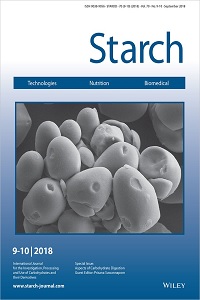Impact of Environment and Genotype-by-Environment Interaction on Functional Properties of Amylose-Free and Wildtype Cassava Starches
Ten and thirty cassava genotypes producing wildtype and amylose‐free (waxy) starch respectively, are grown at low (LA) and intermediate (IA) altitudes (<213 and >900 m above sea level (m.a.s.l.) respectively). The functional properties of the starch from these materials are analyzed. The relative importance of environment, clones (within starch type) and genotype‐by‐environment interaction (GxE) is assessed through an analysis of variance. GxE effects are non‐significant, whereas environment and clones (within starch type) are highly significant in most of the cases (particularly for waxy starches). Results confirm that waxy cassava starches consistently show higher peak viscosity (PV) compared with wildtypes. Peak viscosity is statistically higher in plants grown in IA compared with those from the same genotypes grown in LA, both for waxy and wildtype genotypes. In a second experiment, a single waxy genotype is grown in five locations ranging from 934 to 1485 m.a.s.l. PV is highest in the location with higher altitude. The second highest PV is measured in starches from the second highest location at 1071 m. Both experiments clearly indicate that PV is positively correlated with altitude above sea level where cassava is grown. Altitude above sea level influenced starch granule size: the higher the altitude the larger the average granule size. Waxy starch granules tend to be larger than those from wildtype genotypes.

